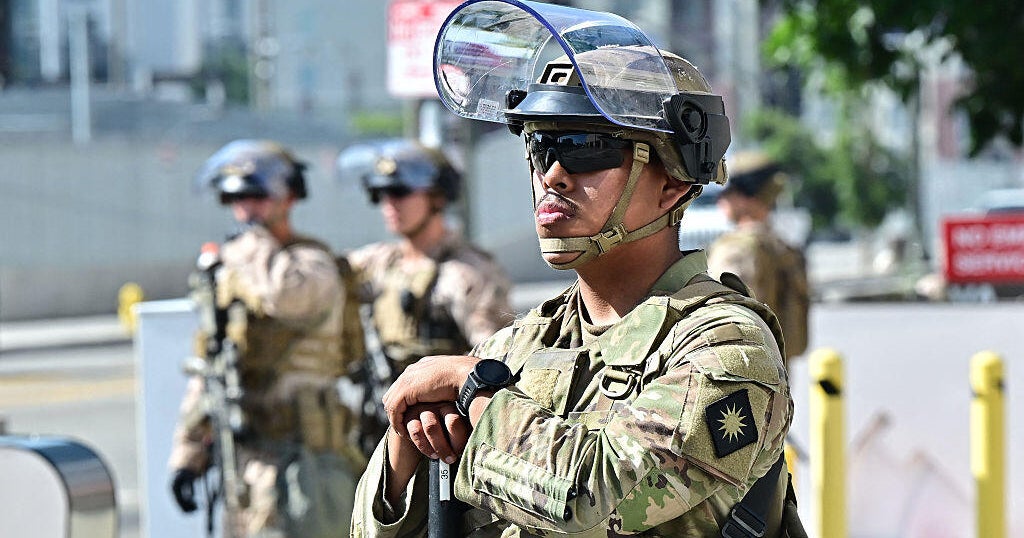In a significant move announced by the Pentagon, the Trump administration is set to relieve thousands of California National Guard members from duty in Los Angeles. This decision follows over a month of deployment, which was initiated by President Trump amidst protests against Immigration and Customs Enforcement (ICE) activities—much to the disapproval of California Governor Gavin Newsom. As the tension between state and federal authorities escalates, key political figures express concerns over the implications of the federal mobilization.
| Article Subheadings |
|---|
| 1) Deployment of National Guard Troops |
| 2) Response from California Officials |
| 3) Legal Controversy and Federal Authority |
| 4) Federal Perspective and Justification |
| 5) Future Implications and Political Reactions |
Deployment of National Guard Troops
On June 1, 2020, the Trump administration exercised its authority to mobilize approximately 4,000 California National Guard troops in response to escalating protests in Los Angeles. These protests were predominantly aimed at ICE operations, which many local residents viewed as excessive. The Pentagon confirmed that around 2,000 troops will be withdrawn from the federal mission in Los Angeles, marking a pivotal shift in the administration’s approach to handling civil unrest. Alongside the National Guardsmen, around 700 active-duty Marines had been deployed for additional security measures to safeguard federal properties.
Response from California Officials
Governor Gavin Newsom, from the outset, voiced staunch opposition to the federal deployment. He labeled the act a politically motivated maneuver rather than a necessary response to local unrest. In a statement released following Tuesday’s announcement, Newsom emphasized, “For more than a month, the National Guard has been pulled away from their families, communities, and civilian work to serve as political pawns for the President in Los Angeles.” The Governor urged the federal administration to bring back the remaining troops, arguing that they have been left without clear directives and their original purpose of assisting their communities has been overshadowed by political agendas.
Legal Controversy and Federal Authority
The deployment itself faced legal challenges led by Governor Newsom, who argued that President Trump overstepped his authority by federalizing the National Guard without his consent. A federal judge initially sided with the state, but an appellate court granted the federal government the authority to keep troops on the ground, indicating that the president likely acted within his jurisdiction. This legal battle reflects a broader conflict between federal and state powers, and raises pressing questions about the legal frameworks governing such deployments.
Federal Perspective and Justification
The Trump administration defended the deployment as a necessary measure to restore order amid chaotic protests. Pentagon spokesperson Sean Parnell stated, “Thanks to our troops who stepped up to answer the call, the lawlessness in Los Angeles is subsiding.” The federal government’s justification stemmed from the need to protect ICE agents and federal properties in the wake of violent encounters during protests. Vice President JD Vance reiterated this perspective during a visit to Los Angeles, asserting that the situation had improved considerably since the Guardsmen’s arrival. However, local officials continued to criticize the deployment as unnecessary and a source of heightened tensions within the community.
Future Implications and Political Reactions
The release of National Guard members could signal a de-escalation in federal involvement in local protests, but the situation remains fluid. Governor Newsom and other local representatives express skepticism about the administration’s intentions, worried that further interventions could lead to additional strife. Furthermore, the Vice President hinted at the possibility of deploying Guard troops to other U.S. locations if deemed necessary, raising concerns about whether such actions could become a recurring practice across the nation. As the dust settles, the repercussions of this incident will likely resonate in ongoing discussions about the appropriate balance of power between state and federal authorities, especially in times of civil unrest.
| No. | Key Points |
|---|---|
| 1 | About 2,000 National Guard members are being released from a federal mission in Los Angeles. |
| 2 | Governor Gavin Newsom has been critical of the federal deployment, labeling it unnecessary. |
| 3 | The deployment faced legal challenges asserting President Trump’s authority was overreaching. |
| 4 | Federal officials claimed the troops were essential for maintaining order amid protests. |
| 5 | Future implications of such deployments may influence the balance between federal and state governance. |
Summary
The recent decision to withdraw thousands of National Guard troops from Los Angeles comes amid intense political discourse surrounding the role of federal authority in state matters. Governor Gavin Newsom has voiced significant opposition, highlighting concerns about the politicization of the National Guard, while Trump administration officials argue the deployment was crucial for public safety. As the legal battles continue and future federal interventions loom, this situation may serve as a critical case study in the dynamics of state versus federal powers in managing civil unrest.
Frequently Asked Questions
Question: Why were National Guard troops deployed in Los Angeles?
The National Guard troops were deployed to respond to escalating protests against Immigration and Customs Enforcement (ICE) actions, aiming to maintain order and protect federal properties.
Question: What concerns did Governor Newsom express regarding the deployment?
Governor Gavin Newsom criticized the deployment as an “unprecedented power grab,” claiming it was politically motivated and detrimental to the well-being of National Guard members and their communities.
Question: What were the legal ramifications surrounding this deployment?
The deployment faced legal challenges initiated by Governor Newsom, who argued that President Trump overstepped his authority. A federal court initially sided with the Governor, but an appellate court allowed the federal government to maintain control of the troops.


